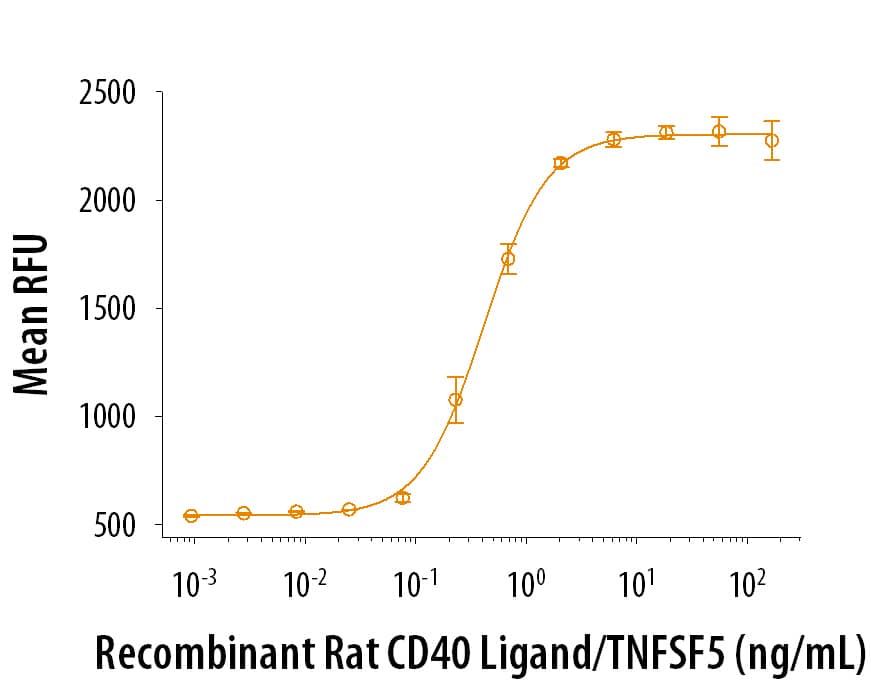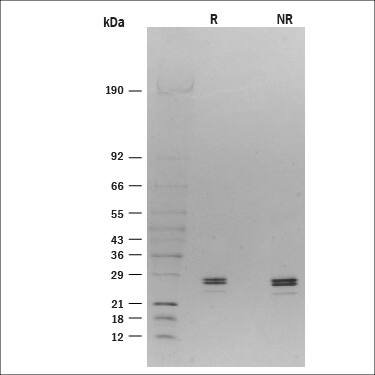Recombinant Rat CD40 Ligand/TNFSF5 (HA-tag) Protein
R&D Systems, part of Bio-Techne | Catalog # 8414-CL

Key Product Details
Product Specifications
Source
| HA (YPYDVPDYA) |
GCN4-IZ | GGGSGGGSGGGS | Rat CD40 Ligand (Met112-Leu260 Accession # Q9Z2V2 |
| N-terminus | C-terminus | ||
Purity
Endotoxin Level
N-terminal Sequence Analysis
Predicted Molecular Mass
SDS-PAGE
Activity
The ED50 for this effect is 0.15-0.9 ng/mL in the presence of 0.1 μg/mL of the cross-linking antibody, Mouse Anti-Hemagglutinin/HA Peptide Monoclonal Antibody (Catalog # MAB060).
Scientific Data Images for Recombinant Rat CD40 Ligand/TNFSF5 (HA-tag) Protein
Recombinant Rat CD40 Ligand/TNFSF5 Protein SEC-MALS.
Recombinant Rat CD40 Ligand/TNFSF5 (Catalog # 8414-CL) has a molecular weight (MW) of 67.1 kDa as analyzed by SEC-MALS, suggesting that this protein is a homotrimer. MW may differ from predicted MW due to post-translational modifications (PTMs) present (i.e. Glycosylation).Recombinant Rat CD40 Ligand/TNFSF5 (HA-tag) Protein Bioactivity
Recombinant Rat CD40 Ligand (Catalog# 8414-CL) induces cell proliferation by mouse splenic B cells in the presence of IL-4. The ED50 for this effect is 0.15-0.9 ng/mL in the presence of 0.1 µg/mL of the cross-linking antibody, Mouse Anti-Hemagglutinin/HA Peptide Monoclonal Antibody (Catalog # MAB060).Recombinant Rat CD40 Ligand/TNFSF5 (HA-tag) Protein SDS-PAGE
1 μg/lane of Recombinant Rat CD40 Ligand/TNFSF5 was resolved with SDS-PAGE under reducing (R) and non-reducing (NR) conditions and visualized by silver staining, showing R bands at 26, 28 kDa and NR bands at 26, 28 kDa.Formulation, Preparation and Storage
Carrier Free
What does CF mean?CF stands for Carrier Free (CF). We typically add Bovine Serum Albumin (BSA) as a carrier protein to our recombinant proteins. Adding a carrier protein enhances protein stability, increases shelf-life, and allows the recombinant protein to be stored at a more dilute concentration. The carrier free version does not contain BSA.
What formulation is right for me?In general, we advise purchasing the recombinant protein with BSA for use in cell or tissue culture, or as an ELISA standard. In contrast, the carrier free protein is recommended for applications, in which the presence of BSA could interfere.
Carrier: 8414-CL
| Formulation | Lyophilized from a 0.2 μm filtered solution in PBS and NaCl with BSA as a carrier protein. |
| Reconstitution | Reconstitute at 100 μg/mL in steril PBS containing at least 0.1% human or bovine serum albumin. |
| Shipping | The product is shipped at ambient temperature. Upon receipt, store it immediately at the temperature recommended below. |
| Stability & Storage | Use a manual defrost freezer and avoid repeated freeze-thaw cycles.
|
Carrier Free: 8414-CL/CF
| Formulation | Lyophilized from a 0.2 μm filtered solution in sterile PBS and NaCl. |
| Reconstitution | Reconstitute at 100 μg/mL in PBS. |
| Shipping | The product is shipped with polar packs. Upon receipt, store it immediately at the temperature recommended below. |
| Stability & Storage | Use a manual defrost freezer and avoid repeated freeze-thaw cycles.
|
Background: CD40 Ligand/TNFSF5
References
- Armitage, R.J. et al. (1992) Nature 357:80.
- Hollenbaugh, D. et al. (1992) EMBO J. 11:4313.
- van Kooten, C. and J. Banchereau (1997) Curr. Opin. Immunol. 9:330.
- Graf, D. et al. (1995) Eur. J. Immunol. 25:1749.
- Mazzei, G.J. et al. (1995) J. Biol. Chem. 270:7025.
- Rickert, R.C. et al. (2011) Immunol. Rev. 244:115.
- Elgueta, R. et al. (2009) Immunol. Rev. 229:152.
- Kornbluth, R.S. (2000) J. Leukoc. Biol. 68:373.
- Chougnet, C. (2003) J. Leukoc. Biol. 74:702.
- Pamukcu, B. et al. (2011) Ann. Med. 43:331.
- Hassan, G.S. et al. (2012) Immunobiology 217:521.
Alternate Names
Gene Symbol
UniProt
Additional CD40 Ligand/TNFSF5 Products
- All Products for CD40 Ligand/TNFSF5
- CD40 Ligand/TNFSF5 cDNA Clones
- CD40 Ligand/TNFSF5 ELISA Kits
- CD40 Ligand/TNFSF5 Luminex Assays
- CD40 Ligand/TNFSF5 Lysates
- CD40 Ligand/TNFSF5 Primary Antibodies
- CD40 Ligand/TNFSF5 Proteins and Enzymes
- CD40 Ligand/TNFSF5 Simple Plex
- CD40 Ligand/TNFSF5 Small Molecules and Peptides
Product Documents for Recombinant Rat CD40 Ligand/TNFSF5 (HA-tag) Protein
Product Specific Notices for Recombinant Rat CD40 Ligand/TNFSF5 (HA-tag) Protein
For research use only


